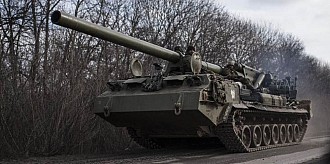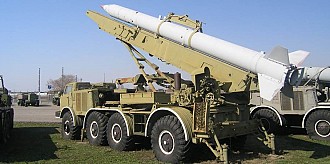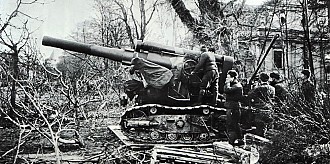Artillery / Towed guns / 180mm S-23
180mm S-23
General Facts
- TYPE
Towed howitzer - ORIGIN
 USSR
USSR - NICKNAMES
203mm M1955 (NATO reporting name)
52-P-572 (GRAU index number) - DESIGNED
1945 - 1955 - DESIGNER
NII-58 design bureau - PRODUCTION
1955 - 1956 (first batch, 7 units)
1971 (second batch, 12 units) - PRODUCERS
 USSR - Barrikady
USSR - Barrikady - QUANTITY
Conflicting reports of many dozens or only 19 units produced. Production complete. - UNIT COST
Unknown - CHARACTERISTICS
 Long range and powerful shells
Long range and powerful shells
 Reportedly has good accuracy
Reportedly has good accuracy
 Heavy and difficult to transport
Heavy and difficult to transport
 Large 16 man crew required.
Large 16 man crew required.
 Limited rate of fire.
Limited rate of fire.
Introduction
The S-23 is a early Cold War era heavy gun of Soviet origin. It was developed after World War 2 to provide Soviet forces with the ability for long range shelling. In the West it was referred to as the 203mm M1955 gun, although its actual caliber is 180mm. When introduced the S-23 had a phenomenal range, good accuracy and reasonable volume of fire. Modern 155mm 52-caliber howitzers offer a similar range and higher rate of fire, but at reduced cost, crew requirement and weight.
Layout
The 180mm 49-caliber ordnance with pepperpot muzzle brake was derived from the older Chapayev naval gun. The gun is mounted on a heavy split trail carriage. The carriage has a single axle with four wheels. A 16 man crew is required for normal operations. No gun shield is provided since the S-23 is to be used well behind the frontline.
Firepower
The S-23 fires powerful 180mm shells at high velocity at ranges up to 30.4 km. Types of shell include high explosive and concrete piercing. Reportedly a nuclear round was deverloped as well. A rocket assisted projectile introduced in the early 1970's extends the maximum range out to 43.8 km. The maximum rate of fire is 1 round per minute. Sustained fire reduces the rate of fire to 1 round every 2 minutes. Accuracy is reported to be good, even at maximum range.
Mobility
The S-23 is a large and heavy gun and as such is difficult to transport. In travelling mode a two wheel dolly is used and the ordnance is withdrawn to the rear in order to reduce overall lenght. A heavy truck or preferably a tracked prime mover is used to tow the gun. In Soviet service the AT-T artillery tractor was used.
Users
The S-23 was adopted by Soviet forces and used at a ratio of 12 weapons per heavy artillery brigade. It was exported to several Soviet allies and was used during several Middle East conflicts. In Soviet service the S-23 was replaced by the self-propelled 2S7 Pion and heavy rocket artillery such as the FROG-7.
S-23
S-23: The S-23 is a large and heavy towed gun. The S-23 is easily identified by its split trail carriage with single axle and double wheels in addition to the long ordnance with pepperpot muzzle brake. Variants that were to use the same carriage have been developed but never left the prototype stage. These prototypes include the S-33 210mm howitzer and S-43 280mm mortar.
- Specifications:
- S-23
| Type | Towed howitzer |
|---|---|
| Crew | 14 to 16 |
| Ordnance | 180mm L/49 howitzer, 8.8 m barrel |
| Elevation | -2 to +50° |
| Traverse | 44° total |
| Rate of fire | 1 rpm (max), 0.5 rpm (sustained) |
|---|---|
| Range | 30.4 km with standard ammunition, 43.8 km with rocket assisted ammunition |
| Carriage | 4 wheel single axle split trail carriage with limber |
| Weight | 19.75 t (firing position), 21.45 t (travelling) |
| Length | 10.48 m (travelling) |
| Width | 2.99 m (travelling) |
|---|---|
| Height | 2.62 m (travelling) |
| Towing vehicle | AT-T artillery tractor |
| Speed | 35 km/h on roads, 12 km/h in the field |
| Remarks | 30 minute emplacement time. S-85 mechanical sight, PG-1M panoramic sight, MVShP direct fire sight |
180mm ammunition
For the S-23 a small selection of ammunition was developed:
F-572: VF-572 round with F-572 high explosive projectile. Original standard issue round, introduced in 1955.
G-572: VG-572 round with G-572 concrete piercing projectile, introduced in 1955.
VOF-28: VOF-28 round with OF-43 rocket assisted projectile. Introduced in the 1970's.
Reportedly a 0.2 kT nuclear shell was developed as well.
| Category | Artillery round |
|---|---|
| Type | HE-Frag |
| Diameter | 180 mm |
| Length | ? |
| Weight | 88 kg complete round |
| Charge | ? |
|---|---|
| Warhead | HE-Frag, 10.7 kg explosive |
| Fuze | ? |
| Effects | ? |
| Velocity | 860 m/s at muzzle |
| Range | 30.4 km |
|---|---|
| Accuracy | ? |
| Tracer | - |
| Remarks | - |
| Category | Artillery round |
|---|---|
| Type | Concrete piercing |
| Diameter | 180 mm |
| Length | ? |
| Weight | 83 kg complete round |
| Charge | ? |
|---|---|
| Warhead | Concrete piercing |
| Fuze | ? |
| Effects | ? |
| Velocity | ? |
| Range | 30 km |
|---|---|
| Accuracy | ? |
| Tracer | - |
| Remarks | - |
| Category | Artillery round |
|---|---|
| Type | RAP |
| Diameter | 180 mm |
| Length | ? |
| Weight | 84 kg complete round |
| Charge | ? |
|---|---|
| Warhead | HE-Frag, 5.6 kg explosive |
| Fuze | ? |
| Effects | ? |
| Velocity | ? |
| Range | 43.7 km |
|---|---|
| Accuracy | ? |
| Tracer | - |
| Remarks | - |













